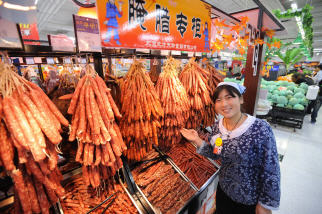January 30, 2014

Last October, Wal-Mart Stores' (WMT) then-CEO, H. Lee Scott Jr., stood at a podium in Beijing's swank Shangri-La Hotel and politely unleashed a litany of demands on the crowd. For the more than 1,000 suppliers gathered in the ballroom, the dynamic was familiar. After all, Wal-Mart became the world's biggest retailer in part by obsessively pressuring its suppliers to cut prices.
But this time the message was different. Rather than hammering on the importance of cutting costs, Scott spent half an hour building a case for why Wal-Mart's vast network of partners—from components makers to factories and shippers—had to go green. "Our goal is for supplier factories to meet or exceed all social and environmental laws and regulations," said Scott. Meeting these standards "is not optional."
To spur these changes, Scott offered both a carrot and a stick. Wal-Mart pledged to work with its top suppliers to help improve their operations, teaching them how to increase energy efficiency and how to cut the amount of raw materials they use. The threat: By 2012, Wal-Mart would pull its orders from companies not meeting the new standards.
Tracking energy use a must
Because of Wal-Mart's size and scale, Scott's pledge rippled across a vast swath of China's manufacturing sector. The company buys some $9 billion worth of goods every year from some 20,000 vendors.
The scope of Wal-Mart's green goals is also without parallel. The mandate requires Chinese factories to track great volumes of data on energy use and to make it available for audits. Wal-Mart's top 200 factories have to become 20 percent more energy-efficient by 2012. "Many Western companies can't track their own energy consumption," says Andrew Winston, consultant and author of the book Green to Gold, who attended the meeting. "Getting Chinese companies to track these kinds of operations data takes [Wal-Mart] many steps forward."
The results already are beginning to trickle in. With Wal-Mart's help, Jiangsu Redbud Dyeing Technology in Changshu City, Jiangsu Province, has cut coal consumption by one-tenth and is aiming to bring toxic emissions down to zero. The company has accelerated new product innovation: Redbud Dyeing has garnered more than 150 patents for its line of environment-friendly jute-based textiles.
Wal-Mart's fast-growing network of 144 Chinese stores is playing a part, too. Adapting green building technologies developed in the U.S., Wal-Mart China is opening stores that use 40-percent less energy than its older stores. In existing sites, it plans retrofits that will reduce energy use by about one-third by 2010. Water is another focus. Over the next two years, Wal-Mart China aims to halve water use by installing water-conservation fixtures in bathrooms, kitchens, and maintenance closets.
Smart tactics spread quickly among factories, says Andrew Hutson, a supply chain expert at the Environmental Defense Fund, a U.S.-based nonprofit environmental group, who has been advising Wal-Mart without receiving compensation. As a rule of thumb, buyers such as Wal-Mart try to divvy up a given order among at least eight factories. Manufacturers, in turn, follow a similar rule: Typically they won't book more than an eighth of the required capacity with a single customer. When a factory accepts Wal-Mart's standards, the plant's other customers are likely to benefit from any efficiency gains. "This is ultimately about making the supply chain more efficient," says Hutson. "If Wal-Mart can help do that, the factories will carry through these practices to all their customers."
It's fair to ask whether managers who are concentrating on going green will still be able to keep a laser-like focus on bringing prices down. Hutson argues that an eco-focus ultimately serves the company's low-price goals. By helping its suppliers cut waste and reduce spending on energy, Wal-Mart fully expects to see those savings passed on in lower prices. "Lowest cost doesn't have to come from past method—the squeeze-'em-till-they-bleed approach. If anything, that approach leads to environmental degradation." he says.
Source: Adam Aston, Business Week
About the Author(s)
You May Also Like


